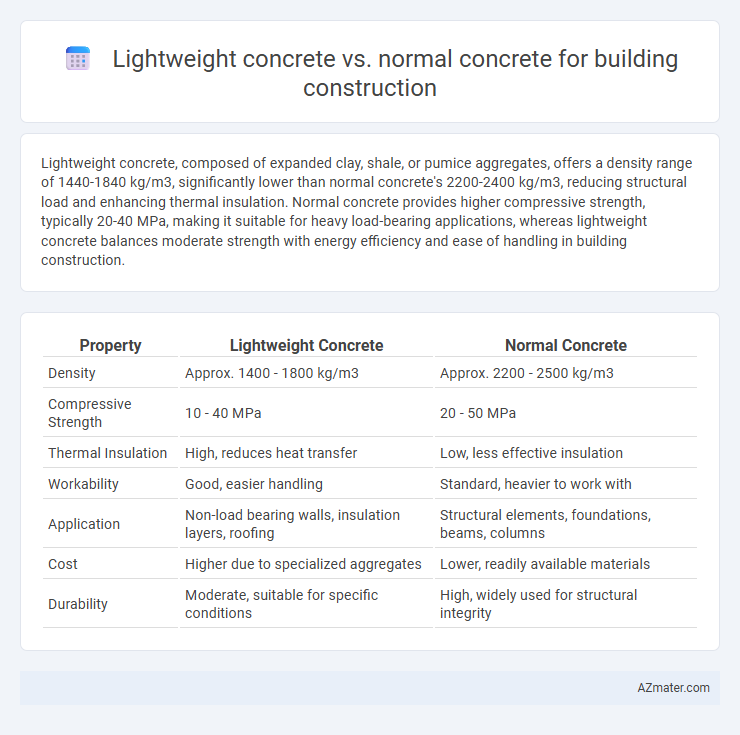Lightweight concrete, composed of expanded clay, shale, or pumice aggregates, offers a density range of 1440-1840 kg/m3, significantly lower than normal concrete's 2200-2400 kg/m3, reducing structural load and enhancing thermal insulation. Normal concrete provides higher compressive strength, typically 20-40 MPa, making it suitable for heavy load-bearing applications, whereas lightweight concrete balances moderate strength with energy efficiency and ease of handling in building construction.
Table of Comparison
| Property | Lightweight Concrete | Normal Concrete |
|---|---|---|
| Density | Approx. 1400 - 1800 kg/m3 | Approx. 2200 - 2500 kg/m3 |
| Compressive Strength | 10 - 40 MPa | 20 - 50 MPa |
| Thermal Insulation | High, reduces heat transfer | Low, less effective insulation |
| Workability | Good, easier handling | Standard, heavier to work with |
| Application | Non-load bearing walls, insulation layers, roofing | Structural elements, foundations, beams, columns |
| Cost | Higher due to specialized aggregates | Lower, readily available materials |
| Durability | Moderate, suitable for specific conditions | High, widely used for structural integrity |
Introduction to Lightweight and Normal Concrete
Lightweight concrete, characterized by its lower density typically ranging from 800 to 1800 kg/m3, incorporates lightweight aggregates such as expanded clay, shale, or pumice, offering enhanced thermal insulation and reduced structural load. Normal concrete, commonly used in construction, has a density of approximately 2200 to 2500 kg/m3 and consists of cement, water, and normal-weight aggregates like gravel and sand, providing high compressive strength and durability. The selection between lightweight and normal concrete depends on specific project requirements including load-bearing capacity, thermal performance, and cost-efficiency.
Composition Differences Between Lightweight and Normal Concrete
Lightweight concrete incorporates lightweight aggregates such as expanded shale, clay, or slate, which reduce its density significantly compared to normal concrete that uses natural aggregates like gravel and crushed stone. The lower density of lightweight concrete results from increased air voids and porous aggregates, whereas normal concrete's composition provides higher compressive strength due to denser, heavier aggregates. The cement content and water-cement ratio may vary slightly in lightweight concrete to maintain workability and strength with unconventional aggregates.
Key Physical Properties Comparison
Lightweight concrete exhibits lower density, typically ranging from 1440 to 1840 kg/m3, compared to normal concrete's 2240 to 2400 kg/m3, resulting in reduced dead loads for building structures. Its enhanced thermal insulation and lower thermal conductivity, around 0.1-0.3 W/mK versus 1.4-2.0 W/mK in normal concrete, improve energy efficiency in buildings. Compressive strength of lightweight concrete generally varies between 17 to 70 MPa, slightly lower than the 20 to 40 MPa typical for normal concrete, affecting structural applications and load-bearing capacities.
Strength and Durability Considerations
Lightweight concrete typically has lower compressive strength compared to normal concrete but offers improved durability in terms of thermal insulation and resistance to freeze-thaw cycles, making it suitable for non-structural elements and reducing dead loads. Normal concrete provides higher compressive strength and superior load-bearing capacity, essential for structural components like beams and columns. Durability in normal concrete often depends on proper mix design and curing, ensuring resistance to abrasion, chemical attack, and long-term performance in load-bearing applications.
Thermal and Acoustic Insulation Performance
Lightweight concrete offers superior thermal insulation due to its lower density and higher air content, reducing heat transfer and enhancing energy efficiency in buildings compared to normal concrete. Its porous structure also provides better acoustic insulation by effectively dampening sound transmission and minimizing noise pollution. Normal concrete, while denser and stronger in compressive strength, lacks the insulation benefits, making lightweight concrete a preferred choice for environments requiring enhanced thermal comfort and noise control.
Structural Applications and Suitability
Lightweight concrete, characterized by its lower density and improved thermal insulation, is highly suitable for structural applications where reduced dead load is critical, such as high-rise buildings and long-span bridges. Normal concrete offers higher compressive strength and durability, making it preferable for foundations, heavy load-bearing columns, and infrastructure requiring superior strength. The choice depends on project requirements, with lightweight concrete optimizing structural efficiency and normal concrete ensuring robustness in load-intensive scenarios.
Weight Reduction and Load-Bearing Implications
Lightweight concrete typically weighs between 1,200 to 1,800 kg/m3, significantly reducing the structural dead load compared to normal concrete, which weighs about 2,400 kg/m3. This weight reduction lessens foundation requirements and improves seismic resistance, making it ideal for multi-story buildings and retrofitting projects. However, its lower compressive strength, usually ranging from 17 to 35 MPa versus normal concrete's 25 to 40 MPa or higher, necessitates careful structural design to ensure adequate load-bearing capacity.
Fire Resistance and Safety Aspects
Lightweight concrete exhibits superior fire resistance compared to normal concrete due to its lower thermal conductivity and enhanced insulating properties, reducing heat transfer during fires. Its cellular structure helps in maintaining structural integrity longer under high temperatures, enhancing overall building safety. Normal concrete, while strong, tends to conduct heat more rapidly, potentially compromising fire resilience in critical structural elements.
Cost Comparison: Material and Installation
Lightweight concrete generally incurs higher material costs compared to normal concrete due to specialized aggregates such as expanded clay or shale. However, its reduced weight can lead to lower installation expenses by minimizing structural load requirements and simplifying transportation. Normal concrete features lower material costs but may increase installation costs through heavier handling and more extensive structural support needs.
Sustainability and Environmental Impact Analysis
Lightweight concrete offers significant sustainability benefits over normal concrete due to its reduced density and lower cement content, leading to decreased carbon emissions during production and transportation. Its enhanced thermal insulation properties improve energy efficiency in buildings, reducing long-term environmental impact through lower heating and cooling demands. Lifecycle assessments consistently show lightweight concrete as a superior choice for eco-friendly construction, minimizing resource depletion and promoting sustainable building practices.

Infographic: Lightweight concrete vs Normal concrete for Building construction
 azmater.com
azmater.com